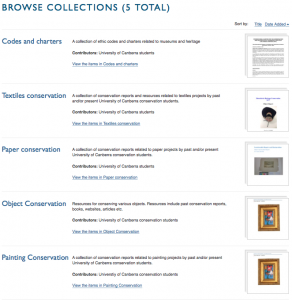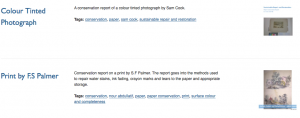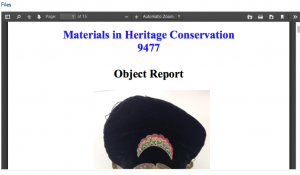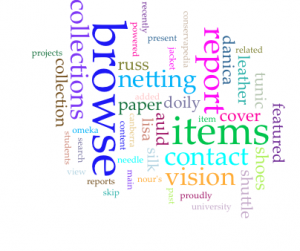Hi everyone,
My project started off as an idea to make some kind of database/forum for conservation students to share resources, projects and anything of the sort. I was originally interested in this idea because I wanted to do something that would reflect my interest (conservation) and potentially help future students; as most of you would know we currently use the Facebook page to share everything but that becomes difficult when you take into account that not everyone has Facebook, and that it is really hard to search through a Facebook page. You don’t have the option of being able to add categories or tags to make searching a bit easier.
Ideally I wanted my project to be something future students could use, something that had pretty much everything they needed in the one location, something that was from students to students and helped give guidance.
With the guidance of Tim I started my project on Omeka.net, a website that lets you create and share collections. Omeka felt appropriate because I would essentially be sharing collections of academic resources.
I initially had a bit of difficulty understanding how to use Omeka. I used Tim’s blog on Omeka and a few other guidelines to help me understand it and I will honestly say that it took me weeks to really know what I was doing with it. But once it clicked I became really excited about the project.
This was a really helpful link I used to help me understand the Dublin Core, which is the set that Omeka.net goes by.
I started by creating the main collection categories:
- Objects
- Paintings
- Paper
- Textiles
- Codes and ethics
I asked students to send me their previous conservation project reports so that I could include them as PDF’s within the appropriate categories. The idea was that a future student could hop onto Conservapedia, click the category that their object falls into, so for example a student working on a painting would hop on and click painting, they would then be able to see the work that previous students have done to paintings, they could see the methodology and resources used and hopefully it would guide them in the right direction for their own project.
While I was putting everything together I started to question the ethics behind this. I had permission from students to use their work and was very open about what it was for but I wasn’t actually sure if publishing assignments was against some kind of policy, if it would somehow feed into plagiarism issues. I asked my classmates and everyone thought it wouldn’t matter and that it should be fine. I think it should be okay, but in retrospect I should have checked with an actual academic at the University to make sure I’m not breaking any rules.
Another issue I had was that I was using the free services on Omeka.net. So basically what that means is that I didn’t have access to all the themes and plugins, and I only had 500mg to work with. Unfortunately I couldn’t afford to buy any of the plans, even the $49 one. My Conservapedia looks a little different to what I had imagined because I only had four themes to choose from, but I am happy with the way it looks.
I was really happy with how helpful people were being; a lot of people wanted to send me their assignments to be included in the project, which was awesome. In my project proposal I said that I would measure the success of this by how many students are interested and participate in this; I don’t think I really met the goal of how many students I wanted to be involved, but I am still happy with the interest that was shown and the number of people who wanted to help and participate.
In my project proposal I said that I wanted students to be able to share things as well as search; this was a bit difficult because you’re only able to view the pages unless you’re signed in. This wasn’t something I really thought about when creating the account and page. In retrospect the username should have been something more communal than “Nour”. Perhaps “CulturalHeritageCollective”.
Initially I wanted a hybrid between a database and a forum but I don’t think Conservapedia is much of a forum. Omeka.net isn’t really the place to host forums, but I decided to stick with it because I think it is really great for most of what I wanted.
Apart from that, I think my project met almost everything I wanted it to.
It is an easy to navigate database for students to share and view resources that could be helpful to their projects.
It is broken down into categories so that you can easily find what you want.

Results:

You can search by key words:


Or tags:

I downloaded a few plugins as well:
Simple pages allows me to add extra pages to my website, so I’ve included a section where I talk about the vision behind Conservapedia, and a contact page so visitors can leave feedback.


I also added a plugin that allows me to have social bookmarks on each individual collection or item page!

My favourite addition was this plugin that imbeds PDF files onto the page.

Originally you would have had to click the PDF icon and it would have opened up the PDF in a new tab, so this plugin allows users to scroll through the document on the original page.
Ironically I was just elected as the social media representative for the UC Cultural Heritage Collective so I think there are so many ways Conservapedia can be extended now that I have this new position within the collective. I honestly think this project relies heavily on public participation and interest, so if other students are interested in this becoming a “thing” then there are ways that I could incorporate it within the collective, and ultimately we could get funding from the collective to buy one of the package deals! In terms of how it can be extended, I think it could naturally grow into something big-ish if enough students are interested in it. It might be an idea to have teacher involvement as well so that our teachers can share important resources with students. The 5 categories that I currently have are all basic categories and I imagine as Conservapedia naturally grows more categories will be appropriate.
I’d like Conservapedia to be something that can be useful for any Heritage, Museums, and Conservation student, in any year level. For example, I’m in my third year, and recently within one of my units we had an assignment where we had to create a poster and present a lightning talk on various topics; a lot of students were lost when it came to creating a poster and we had little examples of what previous years have done. So imagine students from this year all published their posters onto Conservapedia within a Poster category, next years students could easily have access to examples and it would be beyond helpful for them.
In the future I would like students to be able to include 3D images of their objects on Conservapedia.
I think that this could be something cool and I wish I had a more time this semester to work on it but if it is something that I choose to continue with within my new position as social media representative then I think it might be worthwhile. I think if this project were something worth continuing with it would be important to see what other students really want to gain from it so I could cater to those needs.
If anyone is interested in checking out my Conservapedia let me know and I will share the link 🙂
Thanks everyone!
Nour








